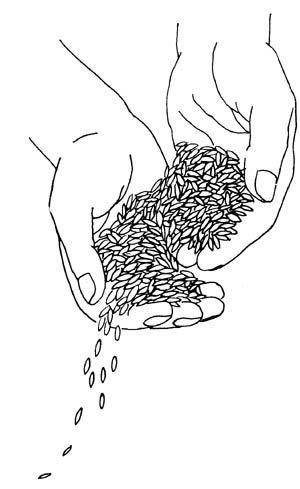|
|
|
|
|
|
|
|
Heirloom wheat and vegetables, popular because of their rich flavor and steady yield in fluctuating weather, can have lower yields than modern cultivars dependent of high inputs. Organic farmers can enhance yield and quality of heirloom crops by selective seed-saving to improve traits, as generations of farmers have done before us, using the following guidelines:
- Decide what crop or cultivar has potential for improvement. Select one or more traits to improve based on the variations of the plants in your field and your market needs, such as cold tolerance for year-round harvest, resistance to disease or attractive appearance.
- Trial and compare the same crop from many different companies, then work on the best lines with the characteristics you seek from the widest genepool you can collect. Use your intuition.
- Plant the crop in well-spaced rows so you can evaluate each plant. Grow as large a population as possible to maintain a diverse pool of traits. Isolate to prevent accidental cross-pollination, unless you are deliberately crossing to create new crop combinations. Allow wild native plants to grow up around and inter-cropped in your fields to attract beneficial pollinators and predators of insect pests.
- Screen out the weaker plants using typical fertilization and irrigation with even field conditions and management for all plants. Don't baby the crop. Remove or market the less desirable plants before flowering to prevent cross-pollination with the superior mother plants. Keep the whole plant in mind as you select so as not to unwittingly select out valuable but less visible traits. Save the best plants for seed.
Tip: For cross-pollinating crops of pre-flower green leaves (ie brassicas), evaluate, taste and rogue out the less desirable plants to sell or eat. Let only the best plants cross-pollinate. For crops of post-flower fruits (ie:cucurbits) evaluate and taste the first fruits of all plants, tag the best plants, then rogue out the poorer plants (alas nothing available to sell at this stage) - to prevent lower quality plants from pollinating the better plants.

|
 Brandywine is larger, later, less uniform, tender, less productive with rich flavor. Considered the most esteemed late nineteenth century heirloom tomato. It has potato-like leaves and large, meaty, reddish-pink fruit, with an indeterminate growth habit. Rose de Berne is medium size, beautiful, almost blemish-free, pink translucent skin covering luscious, rose-pink flesh that is complexly sweet, spicy, and juicy. An unforgettable fresh-eating tomato. Rare Swiss heirloom. Start indoors. Plant two to three feet apart in good garden loam after last frost. |
 |
 |
 |
Let cross-pollinating varieties grow together. Select for unique salad greens. 1. Mizpoona (Mizuna x Tatsoi), 2. Lacinato Rainbow Kale. 3. Purple Mizuna <wildgardenseed.com> |

